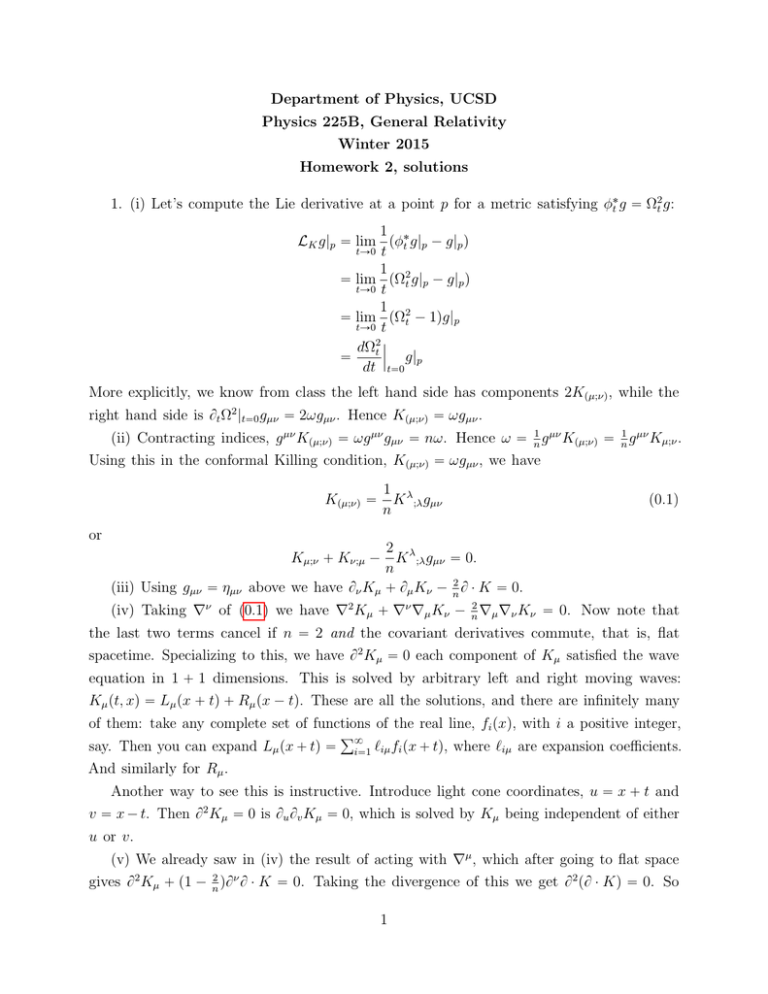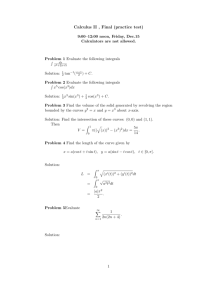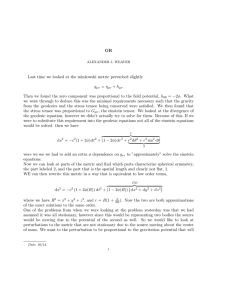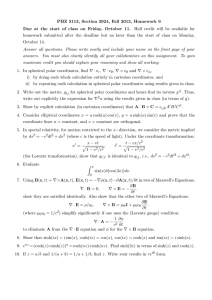Department of Physics, UCSD Physics 225B, General Relativity Winter 2015 Homework 2, solutions
advertisement

Department of Physics, UCSD
Physics 225B, General Relativity
Winter 2015
Homework 2, solutions
1. (i) Let’s compute the Lie derivative at a point p for a metric satisfying φ˚t g “ Ω2t g:
1
LK g|p “ lim pφ˚t g|p ´ g|p q
tÑ0 t
1
“ lim pΩ2t g|p ´ g|p q
tÑ0 t
1
“ lim pΩ2t ´ 1qg|p
tÑ0 t
dΩ2t ˇˇ
“
ˇ g|p
dt t“0
More explicitly, we know from class the left hand side has components 2Kpµ;νq , while the
right hand side is Bt Ω2 |t“0 gµν “ 2ωgµν . Hence Kpµ;νq “ ωgµν .
(ii) Contracting indices, g µν Kpµ;νq “ ωg µν gµν “ nω. Hence ω “ n1 g µν Kpµ;νq “ n1 g µν Kµ;ν .
Using this in the conformal Killing condition, Kpµ;νq “ ωgµν , we have
1 λ
K ;λ gµν
n
Kpµ;νq “
or
(0.1)
2 λ
K ;λ gµν “ 0.
n
above we have Bν Kµ ` Bµ Kν ´ n2 B ¨ K “ 0.
Kµ;ν ` Kν;µ ´
(iii) Using gµν “ ηµν
(iv) Taking ∇ν of (0.1) we have ∇2 Kµ ` ∇ν ∇µ Kν ´ n2 ∇µ ∇ν Kν “ 0. Now note that
the last two terms cancel if n “ 2 and the covariant derivatives commute, that is, flat
spacetime. Specializing to this, we have B 2 Kµ “ 0 each component of Kµ satisfied the wave
equation in 1 ` 1 dimensions. This is solved by arbitrary left and right moving waves:
Kµ pt, xq “ Lµ px ` tq ` Rµ px ´ tq. These are all the solutions, and there are infinitely many
of them: take any complete set of functions of the real line, fi pxq, with i a positive integer,
ř
say. Then you can expand Lµ px ` tq “ 8
i“1 `iµ fi px ` tq, where `iµ are expansion coefficients.
And similarly for Rµ .
Another way to see this is instructive. Introduce light cone coordinates, u “ x ` t and
v “ x ´ t. Then B 2 Kµ “ 0 is Bu Bv Kµ “ 0, which is solved by Kµ being independent of either
u or v.
(v) We already saw in (iv) the result of acting with ∇µ , which after going to flat space
gives B 2 Kµ ` p1 ´ n2 qB ν B ¨ K “ 0. Taking the divergence of this we get B 2 pB ¨ Kq “ 0. So
1
B ¨ Kpxq is linear in x and Kµ pxq at most quadratic. We are looking for a solution of the
conformal killing equation in (iii), and we make an ansatz
Kµ pxq “ aµ ` bµν xν ` 12 cµνλ xν xλ .
Notice that by construction cµνλ “ cµλν . Plugging into the equation and equating to zero
separately the different powers of x we find
bµν ` bµν “ n2 bλ λ ηµν
(0.2)
cµνλ ` cνµλ “ n2 cρ ρλ ηµν
(0.3)
The first of these can be solved by separating the matrix bµν into symmetric and antisymmetri
parts, bµν “ Aµν ` Sµν with Aµν “ ´Aνµ and Sµν “ Sνµ . Then Eq. (0.2) gives no constraint
on Aµν and gives that Sµν is proportional to the metric, Sµν “ sηµν . In order to solve (0.3)
we use a trick you may have seen before (in connection with solving for the connection,
Γµνλ ): re-write the equation twice, with the indices cyclically permuted,
cµνλ ` cνµλ “ n2 cρ ρλ ηµν
cνλµ ` cλνµ “ n2 cρ ρµ ηνλ
cλµν ` cµλν “ n2 cρ ρν ηλµ
and subtract the middle one from the sum of the outer ones:
cµνλ “ n1 pcρ ρλ ηµν ` cρ ρν ηλµ ´ cρ ρµ ηνλ q ” cλ ηµν ` cν ηλµ ´ cµ ηνλ
Combining these results we have
Kµ “ aµ ` Aµν xν ` sxµ ` 2c ¨ xxµ ´ cµ x2
We recognize aµ as generating translations and Aµν generating Lorentz transformations.
Together they form the Poincare group. These are isometries (not merely up to conformal
transformations) and as we know there are n ` 12 npn ´ 1q “ 12 npn ` 1q of them. It is easy
to recognize s as generating dilatations, xµ Ñ es xµ . The last one is harder to understand.
δxµ “ 2c ¨ xxµ ´ cµ x2 is an infinitesimal version of a conformal transformation. The finite
form of the transformation is most easily described as an inversion (xµ Ñ ´xµ {x2 ) followed
by a translation (xµ Ñ xµ ` aµ ) followed by another inversion.
(vi) Compute, compute, compute... Start from δAµ “ pLK Aqµ “ K λ Bλ Aµ ` Bµ K λ Aλ and
compute the variation of the Lagrangian density, ´ 41 δpF µν Fµν q “ ´ 12 F µν δFµν “ F µν δBν Aµ ,
2
or
δp´ 41 F µν Fµν q “ F µν Bν pK λ Bλ Aµ ` Bµ K λ Aλ q
“ F µν pBν K λ Bλ Aµ ` K λ Bν Bλ Aµ ` Bν Bµ K λ Aλ ` Bµ K λ Bν Aλ q
“ F µν pBν K λ Bλ Aµ ` Bµ K λ Bν Aλ ` 12 K λ Bλ Fνµ q
“ Bν K λ F µν pBλ Aµ ´ Bµ Aλ q ` 14 Bλ pK λ F µν Fνµ q ´ 14 Bλ K λ F µν Fνµ
“ 12 F µν F λ µ pBν Kλ ` Bλ Kν ´ 12 ηλν B ¨ Kq ` 41 Bλ pK λ F µν Fνµ q
(Steps: line 2 to 3, moved the fourth term in line 2 to second in line 3, and used antisymmetry
in µ Ø ν toset to zero the antisymmetric combination of Bµ Bν and replace 12 Fνµ for Bν Aµ ;
line 3 to 4, combined the first two terms, integrated by parts the third). Now, the first
term has a factor that vanishes if k is a conformal Killing vector in n “ 4 and the last term
is a total derivate which integrates in the action integral, by Stoke’s theorem, to a surface
integral at infinity, which vanishes.
2. (i) We use polar coordinates X 1 “ r cos θ and X 2 “ r sin θ. Eliminate X 0 : use
pX 0 q2 “ 1 ` pX 1 q2 ` pX 2 q2 “ 1 ` r2 so that X 0 dX 0 “ ´X 1 dX 1 ´ X 2 dX 2 “ ´rdr and for
the metric we need
pdX 0 q2 “ p
r2
rdr 2
q
“
dr2
X0
1 ` r2
(0.4)
so that the metric is
r2
dr2
2
2
2
2
ds “ ´
dr ` dr ` r dθ “
` r2 dθ2 .
2
2
1`r
1`r
2
Since r and θ are polar coordinates for X 1,2 , which are unrestricted, we have r P r0, 8q and
θ P r0, 2πq.
(ii) It is easiest to first find an embedding coordinates for the embedding ´pX 0 q2 `
pX 1 q2 ` pX 2 q2 “ ´1 that gives the usual Poincare half-plane metric. To this end let
X0 ` X1 “ u
X 2 “ xu
This is motivated by the a similar choice made in class for deSitter space, that had
t̂ “ lnpw ` uq, x̂ “ x{pw ` uq; see lecture notes. A third relation, needed to fix all
three coordinates X follows from ´pX 0 q2 ` pX 1 q2 ` pX 2 q2 “ ´1 using ´pX 0 q2 ` pX 1 q2 “
3
p´X 0 ` X 1 qpX 0 ` X 1 q “ p´X 0 ` X 1 qu. So we have
ˆ
˙
1
1 ` x2 u 2
0
X “
u`
2
u
ˆ
˙
1 ` x2 u 2
1
1
u´
X “
2
u
X 2 “ xu
Computing the pull back of this map (the embedding) we get
du2 ` u4 dx2
.
u2
Not quite what we wanted, but close. Form the second term it is apparent we want y “ 1{u,
ds2 “
or to be explicit,
1
X “
2
ˆ
x2
1
`y`
y
y
˙
1
X “
2
ˆ
x2
1
´y´
y
y
˙
0
1
(0.5)
X 2 “ x{y
and the pull back is the desired metric.
We can now exhibit the relation between our px, yq and pr, θq coordinates:
?
y ´1 “ u “ X 0 ` X 1 “ ˘ 1 ` r2 ` r cos θ
x{y “ X 2 “ r sin θ
(0.6)
Of course, to get x explicitly you can divide the second by the first. There are tow signs in
the square root, taking the upper sign gives y ą 0 while the lower gives y ă 0.
(iii) The question, by design, is a bit ambiguous. What I hoped you would explore is
the question of whether one of the coordinate system covers more of the manifold than
the other. From the embedding in terms of px, yq it is apparent that one could take y ă 0
just as well as y ą 0, but something really bad happens at y “ 0. If you plot the surface
pX 0 q2 “ 1 ` pX 1 q2 ` pX 2 q2 you realize immediately that it consists of two disconnected
pieces, one for X 0 ě 1 and the other for X 0 ď 1. Our manifold, H2 , corresponds to one
of the disconnected components, X 0 ě 1, and correspondingly, X 0 ` X 1 ą 0. In the px, yq
coordinate system this means y ą 0, while in the pr, θq system that means we have taken
the positive square root in defining X 0 , see, eg, Eq. (0.6).
(iv) We now have pX 0 q2 “ ´1 ` pX 1 q2 ` pX 2 q2 “ ´1 ` r2 so that we still have
X 0 dX 0 “ ´X 1 dX 1 ´ X 2 dX 2 “ ´rdr but Eq. (0.4) is now
pdX 0 q2 “ p
rdr 2
r2
q
“
´
dr2 .
0
2
X
1´r
4
So now the metric is
´r2
dr2
2
2
2
2
` r2 dθ2 .
dr
`
dr
`
r
dθ
“
´
2
2
1´r
r ´1
ş dr
Note that r ě 1. Following the hint, let χ “ ?r2 ´1 “ arccosh r. Then ds2 “ ´dχ2 `
ds2 “ ´
cosh2 χ dθ2 . This is dS 2 , deSitter space in 2 dimensions.
We could also have taken the metric as defining a geometry in the space defined by
ş dr
2
2
2
r ď 1. Then χ “ ?1´r
2 “ arcsin r, which gives ds “ dΩ2 , the metric on S .
3. (i) This is much like what we did in class for maximally symmetric spaces, and we
went through the logic then. Choose:
X 0 “ cosh χ
X 1 “ sinh χ cos θ1
(0.7)
..
.
X n “ sinh χ sin θ1 ¨ ¨ ¨ sin θn´1 sin θn
To be clear, the spacelike vector pX 1 , . . . , X n q of magnitude sinh χ is written in spherical
coordinates in terms of n ´ 1 angles that parametrize points on the unit n-dimensional
sphere.
Now compute the pull-back. Recall, in general, if the map between manifolds (or rather,
between the corresponding coordinate patches) is y a “ y a pxµ q then the pull back of g
pφ˚ gqµν pxq “
By a By b
g pyq.
Bxµ Bxν ab
a
b
Note that this corresponds formally to replace
By a
dxµ
Bxµ
for dy a
in ds2 “ gab dy dy . So we proceed that way:
ds2 “ ´psinh χdχ ` 0 ` ¨ ¨ ¨ ` 0q2 ` pcosh χ cos θ1 dχ ´ sinh χ sin θ1 dθ1 ` 0 ` ¨ ¨ ¨ ` 0q2 ` ¨ ¨ ¨
By construction the second through last term correspond to spherical coordinates with
radius sinh χ se we know they add to pd sinh χq2 `sinh2 χ dΩ2n´1 “ cosh2 χdχ2 `sinh2 χ dΩ2n´1 .
Combining with the first term we have
ds2 “ ´ sinh χ2 dχ2 ` cosh2 χdχ2 ` sinh χ2 d Ω2n´1 “ dχ2 ` sinh2 χ dΩ2n´1 .
(ii) Getting the metric into the analog of the form in Eq. (3) of the assignment is
straightforward: simply let r “ sinh χ, so that dr “ cosh χdχ, or dχ “ dr{ cosh χ “
?
dr{ 1 ` r2 .
5
To get the metric as in Eq. (2) of the assignment we repeat the procedure in the n “ 2
case, generalizing in an obvious way:
1
X “
2
ˆ
1
X “
2
ˆ
0
u`
1
u´
1`p
ř
1`p
ř
i px
i 2
˙
i 2
˙
q qu2
u
i px
q qu2
u
X 1`i “ xi u
where i “ 1, . . . , n ´ 1, and u “ 1{y. Then
ds2 “
ÿ
1
2
pdy
`
pdxi q2 q.
2
y
i
ş
4. A geodesic is an extremum of the path length, ds. To incorporate a constraint into
it we can use the method of Lagrange multipliers, thus:
ż
`
˘
δS “ 0,
where
S“
ds ` 21 λf pXqdτ .
Here λ “ λpτ q is the lagrange multiplier, a function of the affine parameter τ , ds is the
square root of ds2 given by
ds2 “ ´pdX 0 q2 ` pdX 1 q2 ` ¨ ¨ ¨ ` pdX 4 q2
for deSitter, dS
ds2 “ ´pdX 0 q2 ´ pdX 1 q2 ` ¨ ¨ ¨ ` pdX 4 q2
for anti-deSitter, AdS
and f pXq stands for the constraint that defines the embedded submanifold,
f pXq “ ´pX 0 q2 ` pX 1 q2 ` ¨ ¨ ¨ ` pX 4 q2 ´ α2
for deSitter, dS
f pXq “ ´pX 0 q2 ´ pX 1 q2 ` ¨ ¨ ¨ ` pX 4 q2 ` α2
for anti-deSitter, AdS
a
Let’s go through this explicitly for the dS case. Writing ds “ ˘ηM N dX M dX N and
f pXq “ ηM N X M X N ´ α2 , we have
ˆ
˙
ż
1
dX M dδX N
M
N
1
δS “ dτ ˘
ηM N
` 2 δλf pXq ` ληM N X δX
“ 0.
epτ q
dτ
dτ
Using the fact that we have chosen τ to be an affine parameter we take epτ q “ ds{dτ “ 1.
Then, after integration by parts, we derive the conditions
d2 X N
` λX N “ 0
dτ 2
(0.8)
ηM N X M X N ´ α 2 “ 0
(0.9)
¯
6
Taking two derivatives on (0.9) we have
ηM N X M
d2 X N
dX M dX N
“ 0.
`
η
MN
dτ 2
dτ dτ
Note that the second term in this expression is set to a constant, ˘1, by our choice of
affine parameter, and the first term can be simplified, using (0.8), thus
˘ληM N X M X N “ ´ηM N
dX M dX N
“ ¯1
dτ dτ
Since the factor multiplying λ is α2 , a constant, we learn that λ “ ´1{α2 , a constant. We
can then solve the Eqs. (0.8) trivially,
$
&aN cospτ {αq ` bN sinpτ {αq space-like geodesic
X N pτ q “
%aN eτ {α ` bN e´τ {α
time-like geodesic
(0.10)
where aM and bM are arbitrary constants.
We still have to impose the constraint that the solution remains on the hyperboloid,
ηM N X M X N “ α2 , or
η M N aM aN “ η M N b M b N “ α 2 ,
ηM N aM bN “ 0
space-like
(0.11)
ηM N aM aN “ ηM N bM bN “ 0,
2ηM N aM bN “ α2
time-like
(0.12)
Out of the 10 parameters aM , bM only 10 ´ 3 “ 7 are independent. We should be able to
choose an initial point on the geodesic (4 conditions) and also choose the velocity tangent
vector (3 conditions), and yes 3 ` 4 “ 7 matches the freedom we have in the solution.
What do these curves look like?
Space-like geodesics. We can get a first look at the shape of space-like geodesics by
finding a solution to (0.11) with X 0 “ 0, that is with a0 “ b0 “ 0 and |veca|2 “ |~b|2 “ α2 ,
~a ¨ ~b “ 0. Without loss of generality (by making a rotation) we can take a1 “ α, b2 “ α, all
other components zero. The solution,
X M “ αp0, cospτ {αq, sinpτ {αq, 0, 0q
is a circle across the thinest part of the throat of dS space (the equator of the sphere at
X 0 “ 0).
We can find a more general solution as follows. Generally
X 0 “ a0 cospτ {αq ` b0 sinpτ {αq
7
but we are free to shift τ Ñ τ ` τ0 so we can choose a0 “ 0. Then making a rotation (in
space) we can choose a2 “ a3 “ a4 “ 0. This still leaves freedom to make rotations among
the 2–4 components so we can choose b3 “ b4 “ 0. What we mean by this is that once we
find a solution we can make a rotation to make ~a and ~b general (subject to the constraints).
So we have
a1 “ α
and
a
b2 “ ˘ α2 ` pb0 q2
The full solution is
?
X 0 “ b sinpτ {αq, X 1 “ α cospτ {αq, X 2 “ ˘ α2 ` b2 sinpτ {αq
that is, the curve,
X1 “ α
a
X2 ˘
1 ´ pX 0 {bq2 ,
a
1 ` pα{bq2 X 0
This looks like a slice of the throat of dS space at an angle.
Time-like geodesics. The simplest solution of (0.12) has X 2 “ X 3 “ X 4 “ 0, and then
a1 “ a0 , b1 “ ´b0 and a1 b1 “ α2 {4. Moreover, shifting τ Ñ τ ` τ0 we can set a1 “ b1 “ α{2.
Then
X 0 “ α sinhpτ {αq,
X 1 “ α coshpτ {αq
(0.13)
More generally, we take a0 “ ´b0 by a shift in τ (the case a0 “ `b0 gives no solution),
a2 “ ¨ ¨ ¨ “ a4 “ 0 by a rotation, and b3 “ b4 “ 0 by a further rotation. The conditions,
Eqs. (0.12), are
a1 “ a0 ,
pa0 q2 “ pb1 q2 ` pb2 q2 ,
or
1
a1 “ a0 ” a,
2
α2 ´ 12 a2
b1 “
,
a
a0 b1 “ 12 α2 ´ pa0 q2
c
b2 “ ˘α
1´
α2
a2
So we obtain
X 0 “ a sinhpτ {αq
X 1 “ a sinhpτ {αq ` pα2 {aqe´τ {α
a
X 2 “ ˘α 1 ´ pα{aq2 e´τ {α
(0.14)
We can even go further and give the geodesic explicitly in terms of coordinates on dS.
8
Let’s use, for example, the coordinates pt, χ, θ, φq introduced in class, with
X 0 “ α sinhpt{αq
X 1 “ α coshpt{αq cos χ
X 2 “ α coshpt{αq sin χ sin θ cos φ
X 3 “ α coshpt{αq sin χ sin θ sin φ
X 4 “ α coshpt{αq sin χ cos θ
The simple geodesic (0.13) corresponds to
tpτ q “ τ,
χpτ q “ 0
By rotational symmetry one can map this to tpτ q “ τ , χpτ q “ χ0 “ constant. We can do
something analogous for the more general geodesic (0.14), but it is not very illuminating.
For example, the time component gives,
tpτ q “ α sinh´1
“a
‰
sinhpτ
{αq
α
which is simple at large |τ |, e.g., as τ Ñ 8 it gives
tpτ q « τ ` α lnpa{αq
Briefly on AdS So what is different about AdS? We have the same discussion as above
but now with α2 Ñ ´α2 . The role of space-like and time-like is exchanged in (0.10). The
constraints therefore become:
ηM N aM aN “ ηM N bM bN “ ´α2 ,
ηM N aM aN “ ηM N bM bN “ 0,
ηM N aM bN “ 0
2ηM N aM bN “ ´α2
time-like
(0.15)
space-like
(0.16)
We can satisfy (0.15) by taking, eq, a0 “ b1 “ α all others zero. Then X 0 “ α cospτ {αq and
X 1 “ α sinpτ {αq, corresponding to t1 “ τ {α and ρ “ 1 in the coordinates introduced in class
(X 0 “ α sin t1 cosh ρ, X 1 “ α cos t1 cosh ρ, X 2,3,4 “ α sinh ρ n̂2,3,4 with n̂ a unit 3-component).
9






